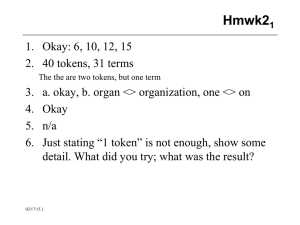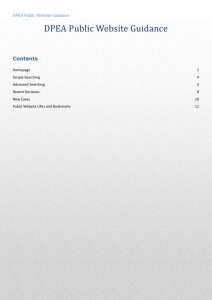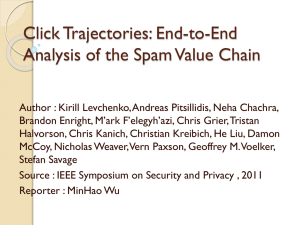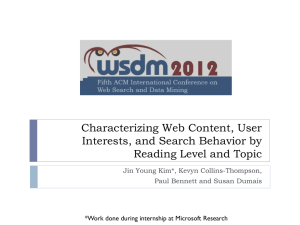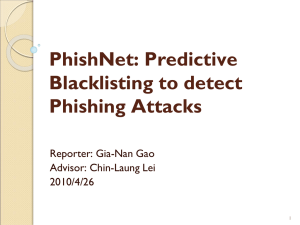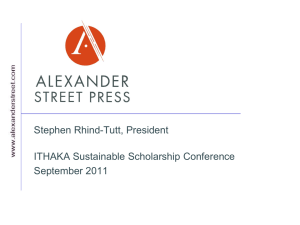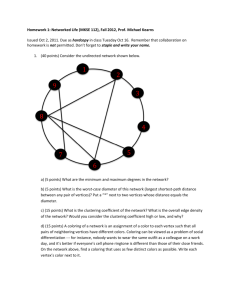URLs Link Rot: Implications for Electronic Publishing D. Vinay
advertisement
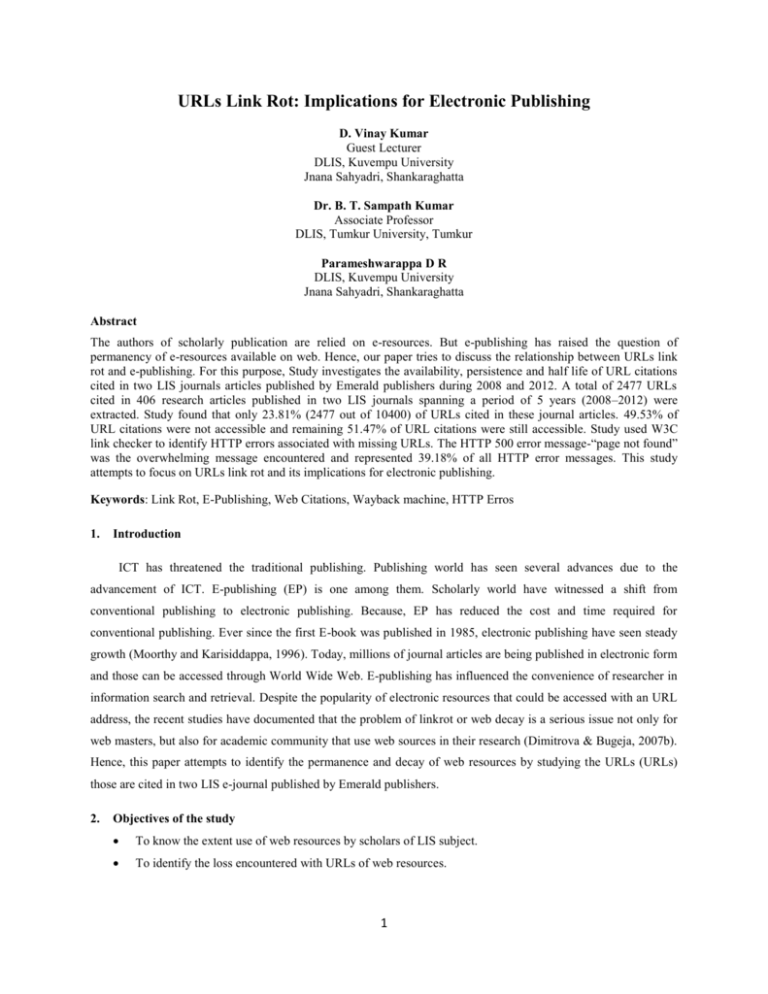
URLs Link Rot: Implications for Electronic Publishing D. Vinay Kumar Guest Lecturer DLIS, Kuvempu University Jnana Sahyadri, Shankaraghatta Dr. B. T. Sampath Kumar Associate Professor DLIS, Tumkur University, Tumkur Parameshwarappa D R DLIS, Kuvempu University Jnana Sahyadri, Shankaraghatta Abstract The authors of scholarly publication are relied on e-resources. But e-publishing has raised the question of permanency of e-resources available on web. Hence, our paper tries to discuss the relationship between URLs link rot and e-publishing. For this purpose, Study investigates the availability, persistence and half life of URL citations cited in two LIS journals articles published by Emerald publishers during 2008 and 2012. A total of 2477 URLs cited in 406 research articles published in two LIS journals spanning a period of 5 years (2008–2012) were extracted. Study found that only 23.81% (2477 out of 10400) of URLs cited in these journal articles. 49.53% of URL citations were not accessible and remaining 51.47% of URL citations were still accessible. Study used W3C link checker to identify HTTP errors associated with missing URLs. The HTTP 500 error message-“page not found” was the overwhelming message encountered and represented 39.18% of all HTTP error messages. This study attempts to focus on URLs link rot and its implications for electronic publishing. Keywords: Link Rot, E-Publishing, Web Citations, Wayback machine, HTTP Erros 1. Introduction ICT has threatened the traditional publishing. Publishing world has seen several advances due to the advancement of ICT. E-publishing (EP) is one among them. Scholarly world have witnessed a shift from conventional publishing to electronic publishing. Because, EP has reduced the cost and time required for conventional publishing. Ever since the first E-book was published in 1985, electronic publishing have seen steady growth (Moorthy and Karisiddappa, 1996). Today, millions of journal articles are being published in electronic form and those can be accessed through World Wide Web. E-publishing has influenced the convenience of researcher in information search and retrieval. Despite the popularity of electronic resources that could be accessed with an URL address, the recent studies have documented that the problem of linkrot or web decay is a serious issue not only for web masters, but also for academic community that use web sources in their research (Dimitrova & Bugeja, 2007b). Hence, this paper attempts to identify the permanence and decay of web resources by studying the URLs (URLs) those are cited in two LIS e-journal published by Emerald publishers. 2. Objectives of the study To know the extent use of web resources by scholars of LIS subject. To identify the loss encountered with URLs of web resources. 1 To check the top-level domain and file format constitute the source of missing as well as recovered URL citations. 3. To determine the implication of URL link rot on Electronic publishing. Methodology The data for the present study were drawn from a selective sample of LIS scholarly journals published by Emerald publishers which are available through the web subscribed by Kuvempu University library. These journals are also published in printed form. The following two journals were selected for the current study. 1. Program 2. The Electronic Library The time frame for the analysis was the publication years 2008–2012. All research articles published during the 5-year period were downloaded and saved. Editorial notes or book reviews were excluded. Totally 10400 references were selected from 406 articles published in the selected Indian LIS journals. Only references that appeared as a list at the end of the article under the bibliography or hypertext reference section were considered. Expanded bibliographies, end notes, foot notes, email links and annotations were not considered and were not tested or counted in our dataset. The study aims only to check the availability of URL citations and their persistence. Duplicate URLs were recognized and removed from the list. W3C link checker (http://validator.w3.org/checklink) was used to check the URLs existence (Sellitto, 2005). The link checker tests a submitted web page for broken or non-valid hypertext links and reports the broken links encountered. After initial check the checked citations were grouped as ‘active’ and ‘missing’ URL citations. The web sources of the vanished URL addresses were entered in the Way-back machine by copying the exact URL given in the reference list of the journal articles. After that we clicked the ‘Take Me Back’ button in the Wayback machine to retrieve the missing URL archive. 4. Results 4.1 Distribution of articles, citations and URLs It is evident from the table 1 that the number of articles, percentage of citations and percentage of URLs are not consistent during 2008-2012.2012 has witnessed 35.87% of citations where as,2010 recorded 21.21% of citation, The percentage of URLs is varied from the highest of 29.78% in 2009 to a lowest of 18.06% in 2012. Table 1 Year wise distribution of articles, citations and URLs Year Total articles Total citation %Average citations per articles URLs % of URLs % of URLs per articles 2008 75 1859 24.78 477 25.65 6.36 2 2009 98 2122 21.65 632 29.78 6.44 2010 84 1782 21.21 452 25.36 5.38 2011 78 2090 26.79 456 21.81 5.84 2012 71 2547 35.87 460 18.06 6.47 Total 406 10400 25.61 2477 23.81 6.10 Table 2: Summary of Year Wise Active and Missing URLs Year Total URLs Active citations %of citations Missing URLs % of URLs 2008 477 256 53.66 221 46.34 2009 632 195 30.85 437 69.15 2010 452 251 55.53 201 44.47 2011 456 263 57.67 193 42.33 2012 460 310 67.39 150 33.61 Total 2477 1275 51.47 1202 49.53 Out of 2477 URLs 1275 (51.47%) are active, where as 1202 (49.53%) are found missing. 2009 witnessed highest missing percentage of URLs with 69.15% followed by 46.34% in 2008. It is evident from the table that as the age of the URLs increase their permanency is questionable. Because table 2 and figure 1 shows the decreasing trend of missing URLs from 2008 to 2010. Table 3: HTTP ERRORS Error 302 Missing URLs % 4 0.33 3 Retrieved 2 % 50.00 303 2 0.17 2 100.00 400 118 9.82 50 42.37 403 151 12.56 65 43.05 404 439 36.52 159 36.22 406 5 0.42 1 20.00 410 1 0.08 0 0.00 412 1 0.08 0 0.00 415 1 0.08 0 0.00 500 471 39.18 206 43.74 501 3 0.25 1 33.33 502 4 0.33 2 50.00 503 1 0.08 0 0.00 600 1 0.08 0 0.00 1202 100 488 40.60 Total The ‘HTTP 500 error message’ was the overwhelming message encountered and represented 39.18% of all HTTP message and it is followed by HTTP 404 (36.52%) and HTTP 403 (12.56%). 1202 URLs of both journals those showing HTTP errors were entered in the way back machine and the ‘Take me back ‘button was clicked. 40.60% of missing URLs is recovered back from way back machine. The search in the way back machine yielded a total of 488 URLs that could be retrieved successfully. It is interesting to know that 43.74% of URLs were recovered from HTTP 500 error message and 43.05% of them were recovered from HTTP 403 error message. Missing URLs with HTTP 404 error message were recovered at the rate of 36.22%. Table 4: Domains associated with missing & retrieved URLs Domains Total URLs Missing %of citation Retrieved % of citation .org 821 422 51.40 178 42.18 .com/.co .edu 620 296 252 169 40.65 57.09 114 58 45.24 34.32 .gov 101 68 67.33 24 35.29 .ac 191 89 46.60 27 30.34 .net 117 35 29.91 13 37.14 .geo domains 331 167 50.45 74 44.31 Total 2477 1202 48.53 488 40.60 The top-level domain having the greatest number of missing URLs was the .gov domain (67.33%) followed by .edu (57.09%). A notable result is the proportionally low level of loss associated with the .net (29.91%). 4 Table-4 illustrates the distribution of different domains associated with missing and retrieved URLs from the way back machine. URLs with .com/.com(45.24) and geo domains (44.31) are the highest retrieved followed by .org (42.18) and .net (37.14) domains. It is interesting to note that the URLs and URLs with academic .ac (30.34) and educational .edu (34.32) are the least recovered URLs. Table 5: File types associated with retrieved URLs File types Total URLs Html/htm/shtm/xml % Missing % Retrieved % 1622 65.48 733 0.45 300 0.41 .pdf 689 27.82 398 0.58 164 0.41 .doc 22 0.89 13 0.59 3 0.23 .xls 1 0.04 0 0.00 1 0.00 .jpg 0 0.00 0 0.00 0 0.00 .cgi 5 0.20 7 1.40 3 0.43 .jsp 26 1.05 11 0.42 2 0.18 112 4.52 40 0.36 15 0.38 2477 100.00 1202 0.49 488 0.41 .php/txt Total The data as illustrated in Table 8 indicates that the greatest numbers of cited web resources are HTML/HTM files (65.48%). Out of 2477 URLs, 1622 cases are HTML files, followed by 689 (27.82%) are PDF files and 112 are PHP files (4.52%). Table also depicts the distribution of recovered URLs having different file types. URLs with PDF file types (41.20) and html file types (40.81) recorded highest recovery where as URLs with .jsp file types and .doc recorded 18.18% and 23.07 respectively which is very low recovery rate.PDF files show highest recovery than of other file types. Table 6: Path Depth associated with retrieved URLs Path depth Total URLs 0 155 1 2 % Missing %of citation Retrieved % of citation 6.26 69 44.51 21 30.43 270 10.90 133 49.26 68 51.12 635 25.64 287 45.19 126 43.9 5 3 552 22.29 268 48.55 109 40.67 4 492 19.86 235 47.77 101 42.97 5 198 7.99 111 56.06 32 28.82 6 88 3.55 47 53.4 21 44.68 7 53 2.14 33 62.26 7 21.21 8 34 1.37 19 55.88 3 15.78 Total 2477 100 1202 48.53 488 40.59 The data presented in table 6 and figure 3 illustrates the missing and recovered URLs on the basic of their path depth. The analysis of the table shows that highest the path depth of the URLs leads to les recovery whereas, lower the path depth is likely to be higher recovery .Because, path depth 1records 51.12% of recovery where as URLs with path depth of >8 are very less retrieved i.e.15.78%. URL with path depth of 4 and less shows highest recovery, where as URLs with the path depth of 7 and above recorded less recovery. Table 7: Character Length associated with retrieved URLs Character length of URLs Total URLs Missing %of citation Retrieved % of citation 0-20 73 32 43.84 13 40.62 21-30 174 73 41.95 36 49.31 31-40 346 150 43.35 80 53.33 6 41-50 618 266 43.04 122 45.86 51-60 416 255 61.30 111 43.52 61-70 332 168 50.60 63 37.50 >70 465 258 55.48 63 24.41 Total 2477 1202 48.53 488 40.60 The distribution of URLs by character length is given in Table 7. Table illustrates the percentage of missing URLs and recovered URLs from various URLs having number of character. The highest percentage of missing URLs (61.30%) was found in the URLs having 51-60 characters followed by >70 character length (55.48%). It clears from the analysis of the table that the higher the character length of URLs lowers the recovery rate. 5. Discussion and Conclusion E-publishing is gained momentum in scholarly world. The low cost to produce information electronically and the speed of publication have made it an inevitable source in the scholarly environment. E-Publishing has given opportunity to post any kind of information on the Internet. But it has also raised the question of unavailability of web pages on the Internet. Several studies have shown that URLs of web pages would disappear as their age increases (Wren et al., Aronsky et al., 2007 – 11.9%; Dimitrova & Bugeja, 2007; Ducut, Liu, & Fontelo, 2008 ; Goh & Ng, 2007; Lopresti, 2010’ Sampath and Vinay, 2013). Since majority of web sources vanished from the original web location due to various reasons, the users of the web find it very difficult to see the needed web sources. There are many reasons why online sources disappear. Some websites simply cease to exist because their website domain names expire. Other web pages are removed from the web by the website creator. Some websites are redesigned with new file structures (Sampth and Vinay, 2013). In the present study we found that 48.53% of URL citations were not accessible and remaining 51.47% of URL citations were still accessible. The HTTP 500 error message – was the overwhelming message encountered and represented 36.52% of all HTTP message. It is also evident from 7 the study that different domains associated with URLs are liable to disappear. URLs with .gov domain found to highest missing which represents 67.33% of the total followed by .org domain (57.09%). Many studies (Dimitrova & Bugeja, 2007a; Wren et al., 2006) have already recommended various strategies for the publishers, editors and authors in order to increase the rate of availability of URLs. Wren et al. opined that loss of URLs would be continued until better preservation policies are adopted. Authors are in vulnerable position to maintain the web pages who post content on the Internet. They are often ill equipped to maintain it (Sampth and Vinay, 2013). But authors may give parallel citations to e-resources that are referred in their scholarly work. In the long term, all research organizations must come to the realization that, due to the dynamic nature of the Internet, certain minimum standards must be maintained in posting scholarly information there (Altman & King, 2007). It is recommended to publishers of electronic web pages that they have to maintain lower path depth in the URL address. Because several studies identified that lower the path depth lesser the missing citations (Goh and Ng, 2007; Sampath and Vinay, 2013). Apart from this, the Digital Object Identifier (DOI) system could be used with the URLs of electronic resources. It is considered as PURL- Persistence Uniform Resources Locator. It would be solution to disappearing act of web pages (DOI.org, 2012). References 1. Altman, M. and King, G. 2007. A proposed standard for the scholarly citation of quantitative data. DLibMagazine. Available from. http://www.dlib.org/dlib/march07/altman/03altman.html 2. Aronsky, D., Madani, S., Carnevale, R. J., Duda, S., and Feyder, F. T. 2007 The prevalence and inaccessibility of Internet references in the biomedical literature at the time of publication. Journal of the American Medical Informatics Association, 14(2), 232–234. 3. Dimitrova, D. V., and Bugeja, M. 2007 The half-life of Internet references cited in communication journals. New Media & Society, 9(9), 811–826. 4. DOI.org. 2012 DOI System and Persistent URLs (PURLs). Website URL http://www.doi.org/factsheets/DOI_PURL.html (accessed on 01, July, 2013) 5. Ducut, E., Liu, F., and Fontelo, P. 2008 An update on uniform resource locators (URL) decay in MEDLINE abstract and measures for its mitigation. BMC Medical Informatics and Decision Making, 8, 23. Website URL http://www.biomedcentral.com/1472-6947/8/23 (accessed on 05 July, 2013). 6. Goh, D. H. L., & Ng, P. K. (2007). Link decay in leading information science journals. Journal of the American Society for Information Science and Technology, 58(1), 15–24. 7. Moorthy, Lakshmana R. and Karisiddappa, C.R. 1996. Electronic Publishing: Impact and implications on library and Information centres. pp. 15-34. In Digital Libraries: Dynamic storehouse of digitized information, edited by Malwad, N.M., Rajashekar, T. B., Rao, Ravichandra. I. K. & Satyanarayana, N. V. New Delhi: New Age International. 8 8. Sampath Kumar and Vinay Kumar 2013. HTTP 404-page (not) found: Recovery of decayed URL citations. Journal of Informetrics, 7, 145-157. Website URL http://dx.doi.org/10.1016/j.joi.2012.09.007 (accessed on 29, June, 2013) 9. Wren, J. D., Johnson, K. R., Crockett, D. M., Heilig, L. F., Schilling, L. M., and Dellavalle, R. P. 2006 Uniform resource locator decay in dermatology journals: author attitudes and preservation practices. Archives of Dermatology, 142, 1147–1152. 9

